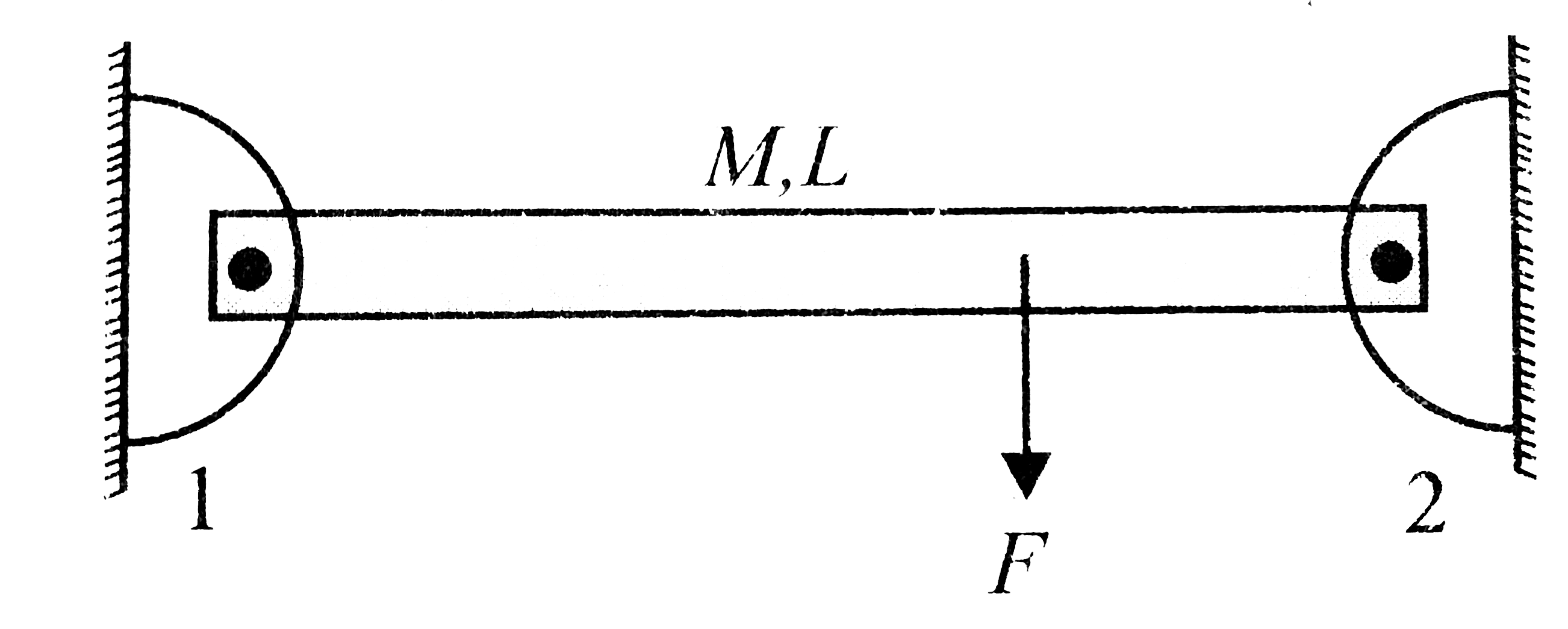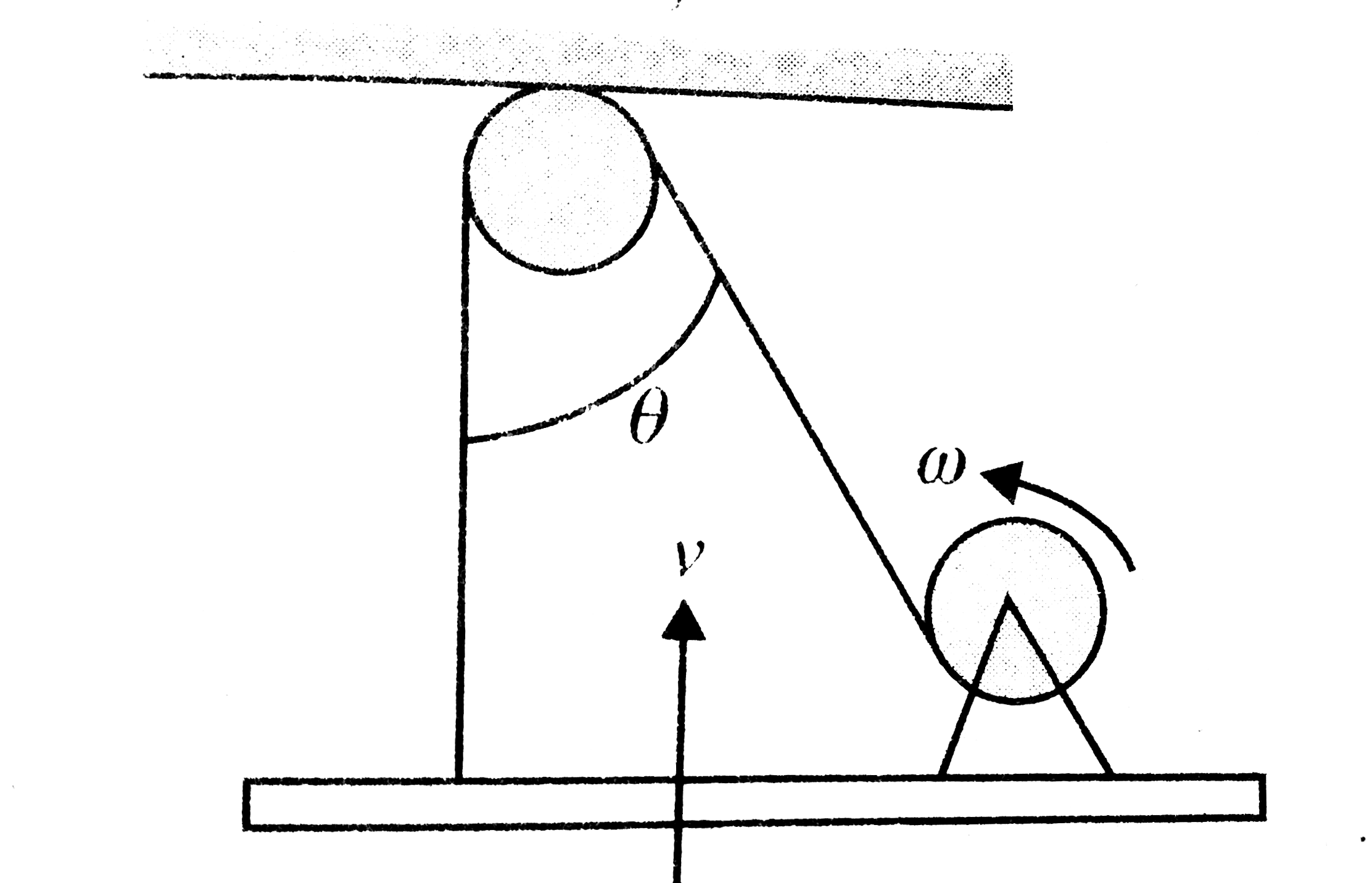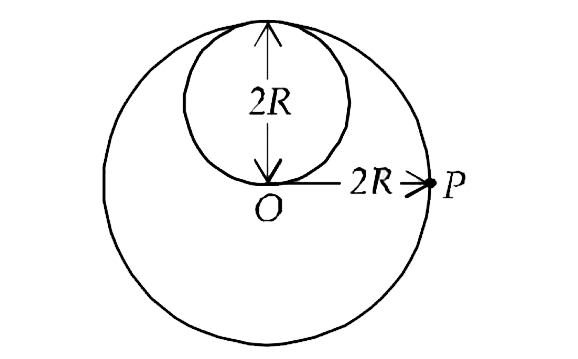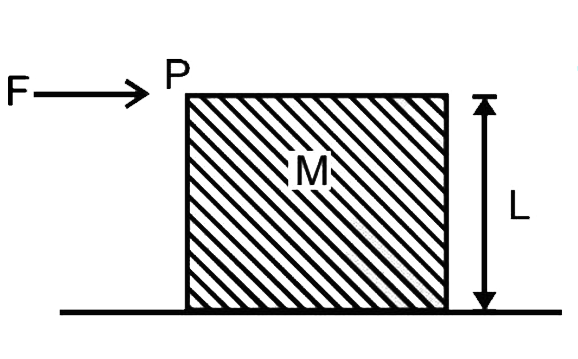A cubical box of side L rests on a rough horizontal surface with coefficient of friction p. A horizontal force F is a applied on the block as shown in Fig. 15.4.6. If the coefficient of friction is sufficiently high so that the block does not slide before toppling, the minimum force required to topple the block is

infinitesimal
mg34
mg2
mg(1−μ)
The correct Answer is:C
Clearly, the block shall topple about its edge through O. The torque FL of the applied force is clockwise. The torque MgL/2 of the weight is anticlock.
Applying condition for rotational equilibrium.
−FL+mgL/2=0 or F=mg2
Topper's Solved these Questions
- RIGID BODY DYNAMICS 1BOOK - CENGAGE PHYSICS ENGLISHCHAPTER - RIGID BODY DYNAMICS 1EXERCISE - Multiple Correct
9 Videos
- RIGID BODY DYNAMICS 1BOOK - CENGAGE PHYSICS ENGLISHCHAPTER - RIGID BODY DYNAMICS 1EXERCISE - Linked Comprehension
28 Videos
- RIGID BODY DYNAMICS 1BOOK - CENGAGE PHYSICS ENGLISHCHAPTER - RIGID BODY DYNAMICS 1EXERCISE - Subjective
12 Videos
- PROPERTIES OF SOLIDS AND FLUIDSBOOK - CENGAGE PHYSICS ENGLISHCHAPTER - PROPERTIES OF SOLIDS AND FLUIDSEXERCISE - INTEGER_TYPE
2 Videos
- RIGID BODY DYNAMICS 2BOOK - CENGAGE PHYSICS ENGLISHCHAPTER - RIGID BODY DYNAMICS 2EXERCISE - Interger
2 Videos
Similar Questions
A rigid body is in pure rotation, that is, undergoing fixed axis rotation. Then which of the following statement(s) are true?
View SolutionA uniform rod of mass M=2kg and length L is suspended by two smooth hinges 1 and 2 as shown in Fig. A force F=4N is applied downward at a distance L/4 from hinge 2. Due to the application of force F, hinge 2 breaks. At this instant, applied force F is also removed. The rod starts to rotate downward about hinge 1. (g=10m/s2)

The reaction at hinge 1, before hinge 2 breaks, is
View SolutionIn the instant shown in the diagram the board is moving up (vertically) with velocity v. The drum winds up at a constant rate ω. If the radius of the drum is R and the board always remains horizontal, find the value of velocity in terms of R,θ,ω.

View SolutionTwo soap bubbles A and B are kept in aclosed chamber where the air is maintained at pressure 8Nm2. The radiiof bubbles A and B are 2cm and 4 cm , respectively. Surface tension of the soap-water used to make bubbles is 0.04 N/m. The ratio of nB/nAis ( where nA and nB are the numbe of moles of air in bubbles A and B,respectively.)
[Neglect the effect of gravity]
View SolutionA lamina is made by removing a small disc of diameter 2R from a bigger disc of uniform mass density and radius 2R, as shown in the figure. The moment of inertia of this lamina about axes passing though O and P is IOandIP respectively. Both these axes are perpendicular to the plane of the lamina. The ratio IPIO is

View SolutionA cubical block of side L rests on a rough horizonta surface with coefficient of friction mu . A horizontal force F is applied on the block as shown. If the coefficient of friction is sufficiently high so that the block does not slide before toppling, the minimum force required to topple the block is
View SolutionAn equilateral prism of mass m rests on a rough horizontal surface with coefficient of friction mu . A horizontal force F is applied on the prism as shown in figure. If the coefficient of friction is sufficiently high so that the prism does not slide before toppling, the minimum force required to topple the prism is
View SolutionA horizontal force F is applied at the top of an equilateral triangular block having mass m . The minimum coefficient of friction required to topple the block before translation will be
View SolutionA cubical block of side L rests on a rough horizontal surface with coefficient of friction mu . A horizontal force F is applied on the block as shown. If the coefficient of frictions sufficienty high so that the block does not slide before toppling, the minimum force required to topple the block is : .
View SolutionA cubical box of side length L rests on a rough horizontal surface having coefficient of friction mu . A variable horizontal force F=alpha t is applied on the top of the block as shown in figure, where alpha is a constant and t is time. The coefficient of friction is sufficient so that the block does not slide before toppling. The graph between torque due to normal reaction about end B and time before toppling start is
View SolutionAn equilateral prism of mass m rests on a rough horizontal surface with coefficient of friction mu . A horizontal force F is applied on the top of prism as shown in figure. If the coefficient of friction is sufficiently high so that the prism does not slide before topping, the minimum force required to topple the prism is
View SolutionA cubical box of side length L rests on a rough horizontal surface having coefficient of friction mu . A variable horizontal force F = alpha t is applied on the top of the block as shown in the figure, where alpha is a constant and t is time. The coefficient of friction is sufficient so that the block does not slide before toppling. The graph between torque due to normal reaction about end B and time before toppling start is
View SolutionA cubical block of side .L. rests on a rough horizontal surface with coefficient of friction μ. A horizontal force F is applied on the block as shown in figure. The minimum force required to topple the block is

View SolutionA cubical block of side .L. rests on a rough horizontal surface with coefficient of friction \i. A horizontal force F is applied on the block as shown in figure. The minimum force required to topple the block is:
View SolutionAn equilateral prism of mass m rests on a rough horizontal surface with ceefficeinet of friction |t. A horizontal force F is applied on the prism as shown. If the coefficeient of friction is sufficiently high so that the prism does not slide before toppling, the minimum force required to topple the prism is:

View SolutionA cubical block of side L rests on a rough horizonta surface with coefficient of friction μ. A horizontal force F is applied on the block as shown. If the coefficient of friction is sufficiently high so that the block does not slide before toppling, the minimum force required to topple the block is

View Solution

